Exploiting Waste towards More Sustainable Flame-Retardant Solutions for Polymers: A Review
Abstract
1. Introduction
2. Classification and Application of Waste-Based Flame Retardant
2.1. Industrial Wastes
2.1.1. Fly Ash (FA)
2.1.2. Steel Slag
2.2. Food Wastes
2.2.1. Eggshell
- (1)
- Direct addition as biofillers
- (2)
- Adding after conversion to calcium-containing compounds
| Polymer | Loading Ratio | LOI (%) | UL-94 | pHRR Decrease (%) | THR Decrease (%) | References |
|---|---|---|---|---|---|---|
| EP Coatings | 17:1 | / | / | 23.1 | 32.2 | [53] |
| PLA | 1:1 | 34.5 | V-0 | / | / | [54] |
| EP Coatings | 20:1 | 31.5 | V-0 | 42.2 | 35.3 | [55] |
| PP | 1:1 | 20.8 | HB:12.9 mm/min | / | / | [57] |
| LLDPE | / | / | HB:20.0 mm/min | / | / | [58] |
| EVA | 1:3 | / | / | 91.0 | / | [59] |
| EVA | 1:2 | / | / | 85.9 | / | [60] |
2.2.2. Bagasse
2.2.3. Banana Peel Powder (BPP)
2.2.4. Oyster Shell Powder (OSP)
2.2.5. Waste Cooking Oil (WCO)
2.2.6. Fish Scales and Fish DNA
2.2.7. Coffee Grounds
2.3. Plant Waste
2.3.1. Rice Husk (RH)
| Polymer | Loading Ratio | LOI (%) | UL-94 | pHRR Decrease (%) | THR Decrease (%) | References |
|---|---|---|---|---|---|---|
| EP | 3:1 | 58.0 | V-0 | 57.6 | 31.3 | [98] |
| EP | 3:1 | 62.0 | V-0 | 59.5 | 64.3 | [99] |
| EP | / | 34.0 | V-0 | / | / | [100] |
| EP | 3:1 | 22.1 | / | 28.6 | 10.6 | [101] |
| PP | 7:20 | 29.3 | / | 58.9 | 15.3 | [102] |
| PP | 2:1 | 42.0 | / | 86.1 | 61.3 | [103] |
| PLA | 2:1 | 32.8 | V-0 | / | / | [105] |
| EVA | / | / | / | 70.0 | 21.0 | [106] |
| HDPE | / | / | / | 65.8 | 22.7 | [107] |
| PU | 3:7/7:93 | 23.0 | V-0 | 34.1 | / | [108] |
2.3.2. Cellulose Nanofibers (CNFs)
2.3.3. Lignin
2.4. Other Wastes
3. Conclusions and Perspective
- (i)
- Reducing waste: By using waste materials as the source of additives for flame-retardant actions, we can reduce the amount of waste that goes to landfills or incinerators. This is important because waste disposal may cause serious environmental problems.
- (ii)
- Cost-effective: Using waste materials to make composite flame retardants is an economical and promising method, since raw resources are often less costly than virgin materials. The utilization of waste materials to make sustainable flame-retardant compounds would aid in waste reduction and the promotion of a circular economy.
- (iii)
- Sustainable: Using waste materials to make flame-retardant substances is a sustainable technique that would help to lessen our dependency on nonrenewable resources.
- (1)
- Developing possibilities for more types of waste utilization. More waste-based flame retardants should be produced and investigated. Agricultural wastes such as corn stalks can be converted into biochar, which has high flame-retardant properties, while other natural materials, e.g., cellulose-based wastes, which can be extracted from corn cobs and wheat straw, and lignocellulosic wastes, such as sawdust and wood chips, can be used to produce sustainable flame retardants.
- (2)
- Comprehensive analysis of the performance and efficacy of waste derivative flame retardants. In order to screen or develop waste-derived flame retardants with high performance, versatility, and significant economic value, researchers need to conduct a comprehensive cost-effectiveness analysis of objective flame retardants, which can include a systematic evaluation of mechanical properties, cost analysis, flame retardancy, and other possible value-added functions. It is worth pointing out that life cycle assessment (LCA) can be used as a practical and systematic method for evaluating related flame retardants. LCA is a well-known process that is documented in international guidelines (ISO 14040, ISO 14044). The socioeconomic and environmental consequences of the whole value chain for any kind of waste-based flameproof product should be examined using LCA and recognized criteria.
Author Contributions
Funding
Institutional Review Board Statement
Informed Consent Statement
Data Availability Statement
Conflicts of Interest
References
- Zhu, Y.Q.; Romain, C.; Williams, C.K. Sustainable polymers from renewable resources. Nature 2016, 540, 354–362. [Google Scholar] [CrossRef] [PubMed]
- Zhao, H.B.; Liu, B.W.; Wang, X.L.; Chen, L.; Wang, X.L.; Wang, Y.Z. A flame-retardant-free and thermo-cross-linkable copolyester: Flame-retardant and anti-dripping mode of action. Polymer 2014, 55, 2394–2403. [Google Scholar] [CrossRef]
- Yan, Y.W.; Chen, L.; Jian, R.K.; Kong, S.; Wang, Y.Z. Intumescence: An effect way to flame retardance and smoke suppression for polystryene. Polym. Degrad. Stab. 2012, 97, 1423–1431. [Google Scholar] [CrossRef]
- Chen, L.; Zhao, H.B.; Ni, Y.P.; Fu, T.; Wu, W.S.; Wang, X.L.; Wang, Y.Z. 3D printable robust shape memory PET copolyesters with fire safety via π-stacking and synergistic crosslinking. J. Mater. Chem. A 2019, 7, 17037–17045. [Google Scholar] [CrossRef]
- Liu, B.W.; Chen, L.; Guo, D.M.; Liu, X.F.; Lei, Y.F.; Ding, X.M.; Wang, Y.Z. Fire-Safe Polyesters Enabled by End-Group Capturing Chemistry. Angew. Chem. Int. Ed. Engl. 2019, 58, 9188–9193. [Google Scholar] [CrossRef] [PubMed]
- Zhang, J.; Li, Z.; Zhang, L.; García Molleja, J.; Wang, D.Y. Bimetallic metal-organic frameworks and graphene oxide nano-hybrids for enhanced fire retardant epoxy composites: A novel carbonization mechanism. Carbon 2019, 153, 407–416. [Google Scholar] [CrossRef]
- Zhang, J.; Li, Z.; Yin, G.Z.; Wang, D.Y. Construction of a novel three-in-one biomass based intumescent fire retardant through phosphorus functionalized metal-organic framework and β-cyclodextrin hybrids in achieving fire safe epoxy. Compos. Commun. 2021, 23, 100594–100601. [Google Scholar] [CrossRef]
- Yang, Y.; Wang, D.Y.; Haurie, L.; Liu, Z.; Zhang, L. Combination of Corn Pith Fiber and Biobased Flame Retardant: A Novel Method toward Flame Retardancy, Thermal Stability, and Mechanical Properties of Polylactide. Polymers 2021, 13, 1562. [Google Scholar] [CrossRef]
- Yang, Y.X.; Haurie, L.; Wang, D.Y. Bio-based materials for fire-retardant application in construction products: A review. J. Therm. Anal. Calorim. 2022, 147, 6563–6582. [Google Scholar] [CrossRef]
- Wang, Y.Z.; Liu, X.Y.; Lan, T.Y.; Yang, Q.; Cong, S.S.; Lin, Y.X. Corn Stalk Biochar-Reinforced High-Density Polyethylene Material: Flame-Retardant and Anti-aging Properties. Fibers Polym. 2023, 24, 1771–1779. [Google Scholar] [CrossRef]
- Dhawan, R.; Bisht, B.M.S.; Kumar, R.; Kumari, S.; Dhawan, S.K. Recycling of plastic waste into tiles with reduced flammability and improved tensile strength. Process Saf. Environ. Prot. 2019, 124, 299–307. [Google Scholar] [CrossRef]
- Kim, Y.; Hwang, S.; Choi, J.; Lee, J.; Yu, K.; Baeck, S.H.; Shim, S.E.; Qian, Y. Valorization of fly ash as a harmless flame retardant via carbonation treatment for enhanced fire-proofing performance and mechanical properties of silicone composites. J. Hazard. Mater. 2021, 404, 124202–124211. [Google Scholar] [CrossRef] [PubMed]
- Ren, Y.F.; Chen, M.Z.; Yang, T.Y.; Wu, S.P.; Wang, K.F. Effect of Steel Slag Aggregate on Pavement and Flame-Retardant Performance of Warm-Mixed Flame-Retardant Asphalt Concrete. Materials 2021, 14, 635. [Google Scholar] [CrossRef] [PubMed]
- Jena, D.K.; Sahoo, P.K. New strategies for the construction of eggshell powder reinforced starch based fire hazard suppression biomaterials with tailorable thermal, mechanical and oxygen barrier properties. Int. J. Biol. Macromol. 2019, 140, 496–504. [Google Scholar] [CrossRef] [PubMed]
- Aqlibous, A.; Tretsiakova-McNally, S.; Fateh, T. Waterborne Intumescent Coatings Containing Industrial and Bio-Fillers for Fire Protection of Timber Materials. Polymers 2020, 12, 757. [Google Scholar] [CrossRef] [PubMed]
- Battig, A.; Gonzalez, K.I.G.; Schartel, B. Valorizing “non-vegan” bio-fillers: Synergists for phosphorus flame retardants in epoxy resins. Polym. Degrad. Stab. 2022, 198, 109875–109890. [Google Scholar] [CrossRef]
- Hemmati, F.; Garmabi, H. A study on fire retardancy and durability performance of bagasse fiber/polypropylene composite for outdoor applications. J. Thermoplast. Compos. Mater. 2013, 26, 1041–1056. [Google Scholar] [CrossRef]
- Han, W.J.; Chen, K.F.; Yang, R.D.; Yang, F.; Zhao, C.S.; Gao, W.H. Utilization of bagasse fiber for preparation of biodegradable flame retarding composites (BFRCS). Bioresources 2010, 5, 1605–1617. [Google Scholar] [CrossRef]
- Yotkuna, K.; Chollakup, R.; Imboon, T.; Kannan, V.; Thongmee, S. Effect of flame retardant on the physical and mechanical properties of natural rubber and sugarcane bagasse composites. J. Polym. Res. 2021, 28, 455–467. [Google Scholar] [CrossRef]
- Elgamsy, R.; Elmagd, A.A.; Mokhtar, A.; Khalid, I.; Taha, N.; Sadek, S.; Tawfic, M.L.; Attia, T.; Elsabbagh, A. Developing fire retardant composites of biodegradable polyethylene reinforced with agricultural wastes. Ain Shams Eng. J. 2022, 13, 101768–101777. [Google Scholar] [CrossRef]
- Chong, M.H.; Chun, B.C.; Chung, Y.C.; Cho, B.G. Fire-retardant plastic material from oyster-shell powder and recycled polyethylene. J. Appl. Polym. Sci. 2006, 99, 1583–1589. [Google Scholar] [CrossRef]
- Kuranska, M.; Benes, H.; Salasniska, K.; Prociak, A.; Malewska, E.; Polaczek, K. Development and Characterization of “Green Open-Cell Polyurethane Foams” with Reduced Flammability. Materials 2020, 13, 5459. [Google Scholar] [CrossRef] [PubMed]
- Song, F.; Zhao, Q.; Zhu, T.Y.; Bo, C.Y.; Zhang, M.; Hu, L.H.; Zhu, X.B.; Jia, P.Y.; Zhou, Y.H. Biobased coating derived from fish scale protein and phytic acid for flame-retardant cotton fabrics. Mater. Des. 2022, 221, 110925–110936. [Google Scholar] [CrossRef]
- Sa, S.C.; Souza, M.M.; Peres, R.S.; Zmozinski, A.V.; Braga, R.M.; Melo, D.M.D.; Ferreira, C.A. Environmentally friendly intumescent coatings formulated with vegetable compounds. Prog. Org. Coat. 2017, 113, 47–59. [Google Scholar]
- Suhot, M.A.; Hassan, M.Z.; Aziz, S.A.; Daud, M.Y.M. Recent Progress of Rice Husk Reinforced Polymer Composites: A Review. Polymers 2021, 13, 2391. [Google Scholar] [CrossRef] [PubMed]
- Borazan, A.A.; Gokdai, D. Pine Cone and Boron Compounds Effect as Reinforcement on Mechanical and Flammability Properties of Polyester Composites. Open Chem. 2018, 16, 427–436. [Google Scholar] [CrossRef]
- Yao, Z.T.; Ji, X.S.; Sarker, P.K.; Tang, J.H.; Ge, L.Q.; Xia, M.S.; Xi, Y.Q. A comprehensive review on the applications of coal fly ash. Earth Sci. Rev. 2015, 141, 105–121. [Google Scholar] [CrossRef]
- Li, J.; Zhuang, X.; Leiva, C.; Cornejo, A.; Font, O.; Querol, X.; Moeno, N.; Arenas, C.; Fernández-Pereira, C. Potential utilization of FGD gypsum and fly ash from a Chinese power plant for manufacturing fire-resistant panels. Constr. Build. Mater. 2015, 95, 910–921. [Google Scholar] [CrossRef]
- Huber, F.; Fellner, J. Integration of life cycle assessment with monetary valuation for resource classification: The case of municipal solid waste incineration fly ash. Resour. Conserv. Recycl. 2018, 139, 17–26. [Google Scholar] [CrossRef]
- Usta, N. Investigation of fire behavior of rigid polyurethane foams containing fly ash and intumescent flame retardant by using a cone calorimeter. J. Appl. Polym. Sci. 2012, 124, 3372–3382. [Google Scholar] [CrossRef]
- Zhou, Q.Q.; Liu, C.K.; Zhou, K.Q.; Xuan, X.; Shi, C.L. Synergistic effect between solid wastes and intumescent flame retardant on flammability and smoke suppression of thermoplastic polyurethane composites. Polym. Adv. Technol. 2020, 31, 4–14. [Google Scholar] [CrossRef]
- Zanoletti, A.; Ciacci, L. The Reuse of Municipal Solid Waste Fly Ash as Flame Retardant Filler: A Preliminary Study. Sustainability 2022, 14, 2038. [Google Scholar] [CrossRef]
- Nguyen, T.A.; Pham, T.M.H. Study on the Properties of Epoxy Composites Using Fly Ash as an Additive in the Presence of Nanoclay: Mechanical Properties, Flame Retardants, and Dielectric Properties. J. Chem. 2020, 2020, 8854515–8854525. [Google Scholar] [CrossRef]
- Song, Y.; Zong, X.; Shan, X.Y.; Zhang, X.; Zou, G.X.; Zhao, C.X.; Li, J.C. Synergistic effect of fly ash on hydroxymethylated lignin-containing flame retardant polypropylene: Flame retardancy and thermal stability. Polym. Adv. Technol. 2021, 32, 1075–1085. [Google Scholar] [CrossRef]
- Park, M.; Kuk, Y.S.; Kwon, O.H.; Acharya, J.; Ojha, G.P.; Ko, J.K.; Kong, H.S.; Pant, B. Fly Ash-Incorporated Polystyrene Nanofiber Membrane as a Fire-Retardant Material: Valorization of Discarded Materials. Nanomaterials 2022, 12, 3811. [Google Scholar] [CrossRef]
- Li, S.Q.; Zhu, X.D.; Li, L.; Qian, Y.; Guo, Q.J.; Ma, J.J. Synthesis of LDHs Based on Fly-Ash and Its Influence on the Flame Retardant Properties of EVA/LDHs Composites. Polymers 2022, 14, 2549. [Google Scholar] [CrossRef]
- Guo, J.; Bao, Y.; Wang, M. Steel slag in China: Treatment, recycling, and management. Waste Manag. 2018, 78, 318–330. [Google Scholar] [CrossRef]
- Zhang, T.S.; Liu, F.T.; Liu, S.Q.; Zhou, Z.H.; Cheng, X. Factors influencing the properties of a steel slag composite cement. Adv. Cem. Res. 2008, 20, 145–150. [Google Scholar] [CrossRef]
- Laachachi, A.; Cochez, M.; Leroy, E.; Gaudon, P.; Ferriol, M.; Lopez Cuesta, J.M. Effect of Al2O3 and TiO2 nanoparticles and APP on thermal stability and flame retardance of PMMA. Polym. Adv. Technol. 2006, 17, 327–334. [Google Scholar] [CrossRef]
- Ma, Z.L.; Fan, C.R.; Lu, G.Y.; Liu, X.Y.; Zhang, H. Synergy of magnesium and calcium oxides in intumescent flame-retarded polypropylene. J. Appl. Polym. Sci. 2012, 125, 3567–3574. [Google Scholar] [CrossRef]
- Li, X.; Zhang, K.; Shi, R.; Ma, X.; Tan, L.; Ji, Q.; Xia, Y. Enhanced flame-retardant properties of cellulose fibers by incorporation of acid-resistant magnesium-oxide microcapsules. Carbohydr. Polym. 2017, 176, 246–256. [Google Scholar] [CrossRef]
- Tang, G.; Liu, X.L.; Zhou, L.; Zhang, P.; Deng, D.; Jiang, H.H. Steel slag waste combined with melamine pyrophosphate as a flame retardant for rigid polyurethane foams. Adv. Powder Technol. 2020, 31, 279–286. [Google Scholar] [CrossRef]
- Yang, S.J.; Liu, X.Y.; Tang, G.; Long, H.M.; Wang, B.B.; Zhang, H.; Ji, Y.L.; Yang, Y.D. Fire retarded polyurethane foam composites based on steel slag/ammonium polyphosphate system: A novel strategy for utilization of metallurgical solid waste. Polym. Adv. Technol. 2022, 33, 452–463. [Google Scholar] [CrossRef]
- Tang, G.; Liu, X.L.; Yang, Y.D.; Chen, D.P.; Zhang, H.; Zhou, L.; Zhang, P.; Jiang, H.H.; Deng, D. Phosphorus -containing silane modified steel slag waste to reduce fire hazards of rigid polyurethane foams. Adv. Powder Technol. 2020, 31, 1420–1430. [Google Scholar] [CrossRef]
- Yew, M.C.; Ramli Sulong, N.H.; Yew, M.K.; Amalina, M.A.; Johan, M.R. The formulation and study of the thermal stability and mechanical properties of an acrylic coating using chicken eggshell as a novel bio-filler. Prog. Org. Coat. 2013, 76, 1549–1555. [Google Scholar] [CrossRef]
- Avella, M.; Carfagna, C.; Cerruti, P.; Errico, M.E.; Gentile, G. Nylon Based Nanocomposites: Influence of Calcium Carbonate Nanoparticles on the Thermal Stability. Macromol. Symp. 2006, 234, 163–169. [Google Scholar] [CrossRef]
- Yoo, S.; Hsieh, J.S.; Zou, P.; Kokoszka, J. Utilization of calcium carbonate particles from eggshell waste as coating pigments for ink-jet printing paper. Bioresour. Technol. 2009, 100, 6416–6421. [Google Scholar] [CrossRef]
- Yew, M.C.; Ramli Sulong, N.H.; Chong, W.T.; Poh, S.C.; Ang, B.C.; Tan, K.H. Integration of thermal insulation coating and moving-air-cavity in a cool roof system for attic temperature reduction. Energy Convers. Manag. 2013, 75, 241–248. [Google Scholar] [CrossRef]
- Yew, M.C.; Yew, M.K.; Saw, L.H.; Ng, T.C.; Chen, K.P.; Rajkumar, D.; Beh, J.H. Experimental analysis on the active and passive cool roof systems for industrial buildings in Malaysia. J. Build. Eng. 2018, 19, 134–141. [Google Scholar] [CrossRef]
- Yew, M.C.; Sulong, N.H.R.; Yew, M.K.; Amalina, M.A.; Johan, M.R. Fire Propagation Performance of Intumescent Fire Protective Coatings Using Eggshells as a Novel Biofiller. Sci. World J. 2014, 2014, 805094–805103. [Google Scholar] [CrossRef]
- Yew, M.C.; Sulong, N.H.R.; Yew, M.K.; Amalina, M.A.; Johan, M.R. Eggshells: A novel bio-filler for intumescent flame-retardant coatings. Prog. Org. Coat. 2015, 81, 116–124. [Google Scholar] [CrossRef]
- Yew, M.C.; Yew, M.K.; Saw, L.H.; Ng, T.C.; Durairaj, R.; Beh, J.H. Influences of nano bio-filler on the fire-resistive and mechanical properties of water-based intumescent coatings. Prog. Org. Coat. 2018, 124, 33–40. [Google Scholar] [CrossRef]
- Wang, F.Y.; Liu, H.; Yan, L. Comparative Study of Fire Resistance and Char Formation of Intumescent Fire-Retardant Coatings Reinforced with Three Types of Shell Bio-Fillers. Polymers 2021, 13, 4333. [Google Scholar] [CrossRef]
- Urtekin, G.; Hazer, S.; Aytac, A. Effect of eggshell and intumescent flame retardant on the thermal and mechanical properties of plasticised PLA. Plast. Rubber Compos. 2021, 50, 127–136. [Google Scholar] [CrossRef]
- Xu, Z.S.; Chu, Z.Y.; Yan, L.; Chen, H.G.; Jia, H.Y.; Tang, W.F. Effect of chicken eggshell on the flame-retardant and smoke suppression properties of an epoxy-based traditional APP-PER-MEL system. Polym. Compos. 2019, 40, 2712–2723. [Google Scholar] [CrossRef]
- Chen, X.L.; Zhang, X.Y.; Wang, W.D.; Wang, Y.; Jiao, C.M. Fire-safe agent integrated with oyster shell and melamine polyphosphate for thermoplastic polyurethane. Polym. Adv. Technol. 2019, 30, 1576–1588. [Google Scholar] [CrossRef]
- Younis, A.A.; El-Wakil, A.A. New Composites from Waste Polypropylene/Eggshell Characterized by High Flame Retardant and Mechanical Properties. Fibers Polym. 2021, 22, 3456–3468. [Google Scholar] [CrossRef]
- Jirimali, H.D.; Chaudhari, B.C.; Khanderay, J.C.; Joshi, S.A.; Singh, V.; Patil, A.M.; Gite, V.V. Waste Eggshell-Derived Calcium Oxide and Nanohydroxyapatite Biomaterials for the Preparation of LLDPE Polymer Nanocomposite and Their Thermomechanical Study. Polym. Plast. Technol. Eng. 2018, 57, 804–811. [Google Scholar] [CrossRef]
- Oualha, M.A.; Amdouni, N.; Laoutid, F. Synergistic flame-retardant effect between calcium hydroxide and zinc borate in ethylene-vinyl acetate copolymer (EVA). Polym. Degrad. Stab. 2017, 144, 315–324. [Google Scholar] [CrossRef]
- Oualha, M.A.; Omri, N.; Oualha, R.; Nouioui, M.A.; Abderrabba, M.; Amdouni, N.; Laoutid, F. Development of metal hydroxide nanoparticles from eggshell waste and seawater and their application as flame retardants for ethylene-vinyl acetate copolymer (EVA). Int. J. Biol. Macromol. 2019, 128, 994–1001. [Google Scholar] [CrossRef]
- Shaikh, H.M.; Pandare, K.V.; Nair, G.; Varma, A.J. Utilization of sugarcane bagasse cellulose for producing cellulose acetates: Novel use of residual hemicellulose as plasticizer. Carbohydr. Polym. 2009, 76, 23–29. [Google Scholar] [CrossRef]
- Griffin, G.J. The effect of fire retardants on combustion and pyrolysis of sugar-cane bagasse. Bioresour. Technol. 2011, 102, 8199–8204. [Google Scholar] [CrossRef] [PubMed]
- Maschio, L.J.; Pereira, P.H.; Da Silva, M.L. Preparation and characterization of cellulose/hydrous niobium oxide hybrid. Carbohydr. Polym. 2012, 89, 992–996. [Google Scholar] [CrossRef]
- Guna, V.; Ilangovan, M.; Hu, C.; Venkatesh, K.; Reddy, N. Valorization of sugarcane bagasse by developing completely biodegradable composites for industrial applications. Ind. Crops Prod. 2019, 131, 25–31. [Google Scholar] [CrossRef]
- Shen, M.Y.; Kuan, C.F.; Kuan, H.C.; Ke, C.Y.; Chiang, C.L. Study on preparation and properties of agricultural waste bagasse eco-type bio-flame-retardant/epoxy composites. J. Therm. Anal. Calorim. 2021, 144, 525–538. [Google Scholar] [CrossRef]
- Liu, S.H.; Ke, C.Y.; Chiang, C.L. Thermal Stability, Smoke Density, and Flame Retardance of Ecotype Bio-Based Flame Retardant Agricultural Waste Bagasse/Epoxy Composites. Polymers 2021, 13, 2977–2988. [Google Scholar] [CrossRef]
- Chen, Z.Q.; Jiang, J.C.; Yu, Y.; Chen, G.; Chen, T.T.; Zhang, Q.W. Layer-by-layerassembled bagasse to enhance the fire safety of epoxy resin: A renewable environmental friendly flame retardant. J. Appl. Polym. Sci. 2021, 138, 50032–50045. [Google Scholar] [CrossRef]
- Zhan, W.; Ma, Z.F.; Du, D.L.; Sun, Z.H.; Li, L.X.; Gu, Z.Z.; Chen, L.; Jiang, J.C.; Chen, Z.Q. Effects of bagasse fiber as the renewable environmentally friendly material on the properties of the waterborne intumescent fireproof coating. J. Appl. Polym. Sci. 2022, 139, 52815–52825. [Google Scholar] [CrossRef]
- Srivastava, K.R.; Singh, M.K.; Mishra, P.K.; Srivastava, P. Pretreatment of banana pseudostem fibre for green composite packaging film preparation with polyvinyl alcohol. J. Polym. Res. 2019, 26, 95–105. [Google Scholar] [CrossRef]
- Rambo, M.K.; Schmidt, F.L.; Ferreira, M.M. Analysis of the lignocellulosic components of biomass residues for biorefinery opportunities. Talanta 2015, 144, 696–703. [Google Scholar] [CrossRef]
- Happi Emaga, T.; Robert, C.; Ronkart, S.N.; Wathelet, B.; Paquot, M. Dietary fibre components and pectin chemical features of peels during ripening in banana and plantain varieties. Bioresour. Technol. 2008, 99, 4346–4354. [Google Scholar] [CrossRef]
- Tahir, M.H.; Zhao, Z.; Ren, J.; Rasool, T.; Naqvi, S.R. Thermo-kinetics and gaseous product analysis of banana peel pyrolysis for its bioenergy potential. Biomass Bioenergy 2019, 122, 193–201. [Google Scholar] [CrossRef]
- Kong, F.B.; Nie, B.S.; Han, C.; Zhao, D.; Hou, Y.A.; Xu, Y.X. Flame Retardancy and Thermal Property of Environment-Friendly Poly(lactic acid) Composites Based on Banana Peel Powder. Materials 2022, 15, 5977. [Google Scholar] [CrossRef]
- Kong, F.B.; He, Q.L.; Peng, W.; Nie, S.B.; Dong, X.; Yang, J.N. Eco-friendly flame retardant poly(lactic acid) composites based on banana peel powders and phytic acid: Flame retardancy and thermal property. J. Polym. Res. 2020, 27, 204–215. [Google Scholar] [CrossRef]
- Basak, S.; Ali, S.W. Fire resistant behaviour of cellulosic textile functionalized with wastage plant bio-molecules: A comparative scientific report. Int. J. Biol. Macromol. 2018, 114, 169–180. [Google Scholar] [CrossRef]
- Yoon, G.L.; Kim, B.T.; Kim, B.O.; Han, S.H. Chemical-mechanical characteristics of crushed oyster-shell. Waste Manag. 2003, 23, 825–834. [Google Scholar] [CrossRef]
- Chen, X.L.; Zhang, X.Y.; Wang, Y.; Zhang, X.G.; Jiao, C.M. Synergistic fire safety improvement between oyster shell powder and ammonium polyphosphate in TPU composites. Polym. Adv. Technol. 2019, 30, 1564–1575. [Google Scholar] [CrossRef]
- Chen, X.L.; Zhang, X.Y.; Zhang, X.G.; Jiao, C.M. Influence of isopropyl tris(dioctylphosphoryloxy) titanate for flame-retardant TPU based on oyster shell powder. J. Therm. Anal. Calorim. 2020, 139, 197–206. [Google Scholar] [CrossRef]
- Wu, B.; Sufi, A.; Ghosh Biswas, R.; Hisatsune, A.; Moxley-Paquette, V.; Ning, P.; Soong, R.; Dicks, A.P.; Simpson, A.J. Direct Conversion of McDonald’s Waste Cooking Oil into a Biodegradable High-Resolution 3D-Printing Resin. ACS Sustain. Chem. Eng. 2019, 8, 1171–1177. [Google Scholar] [CrossRef]
- Zhang, H.; Wang, Q.; Mortimer, S.R. Waste cooking oil as an energy resource: Review of Chinese policies. Renew. Sustain. Energy Rev. 2012, 16, 5225–5231. [Google Scholar] [CrossRef]
- Iglesias, L.; Laca, A.; Herrero, M.; Díaz, M. A life cycle assessment comparison between centralized and decentralized biodiesel production from raw sunflower oil and waste cooking oils. J. Clean. Prod. 2012, 37, 162–171. [Google Scholar] [CrossRef]
- De Feo, G.; Di Domenico, A.; Ferrara, C.; Abate, S.; Sesti Osseo, L. Evolution of Waste Cooking Oil Collection in an Area with Long-Standing Waste Management Problems. Sustainability 2020, 12, 8578. [Google Scholar] [CrossRef]
- Gnanaprakasam, A.; Sivakumar, V.M.; Surendhar, A.; Thirumarimurugan, M.; Kannadasan, T. Recent Strategy of Biodiesel Production from Waste Cooking Oil and Process Influencing Parameters: A Review. J. Energy 2013, 2013, 926392. [Google Scholar] [CrossRef]
- Li, W.; Wang, X. Bio-lubricants derived from waste cooking oil with improved oxidation stability and low-temperature properties. J. Oleo Sci. 2015, 64, 367–374. [Google Scholar] [CrossRef]
- Degfie, T.A.; Mamo, T.T.; Mekonnen, Y.S. Optimized Biodiesel Production from Waste Cooking Oil (WCO) using Calcium Oxide (CaO) Nano-catalyst. Sci. Rep. 2019, 9, 18982–18989. [Google Scholar] [CrossRef] [PubMed]
- Asare, M.A.; Souza, F.M.; Gupta, R.K. Waste to Resource: Synthesis of Polyurethanes from Waste Cooking Oil. Ind. Eng. Chem. Res. 2022, 61, 18400–18411. [Google Scholar] [CrossRef]
- Athinarayanan, J.; Periasamy, V.S.; Alshatwi, A.A. Simultaneous fabrication of carbon nanodots and hydroxyapatite nanoparticles from fish scale for biomedical applications. Mater. Sci. Eng. C Mater. Biol. Appl. 2020, 117, 111313–111350. [Google Scholar] [CrossRef]
- Alongi, J.; Han, Z.; Bourbigot, S. Intumescence: Tradition versus novelty. A comprehensive review. Prog. Polym. Sci. 2015, 51, 28–73. [Google Scholar] [CrossRef]
- Alongi, J.; Blasio, A.D.; Cuttica, F.; Carosio, F.; Malucelli, G. Bulk or surface treatments of ethylene vinyl acetate copolymers with DNA: Investigation on the flame retardant properties. Eur. Polym. J. 2014, 51, 112–119. [Google Scholar] [CrossRef]
- Liu, S.H.; Shen, M.Y.; Yang, C.Y.; Chiang, C.L. A Study on Circular Economy Material Using Fish Scales as a Natural Flame Retardant and the Properties of Its Composite Materials. Polymers 2021, 13, 2446. [Google Scholar] [CrossRef]
- Zabihi, O.; Ahmadi, M.; Khayyam, H.; Naebe, M. Fish DNA-modified clays: Towards highly flame retardant polymer nanocomposite with improved interfacial and mechanical performance. Sci. Rep. 2016, 6, 38194–38210. [Google Scholar] [CrossRef]
- Zabihi, O.; Ahmadi, M.; Li, Q.X.; Ferdowsi, M.R.G.; Mahmoodi, R.; Kalali, E.N.; Wang, D.Y.; Naebe, M. A sustainable approach to scalable production of a graphene based flame retardant using waste fish deoxyribonucleic acid. J. Clean. Prod. 2020, 247, 119150–119160. [Google Scholar] [CrossRef]
- Campos-Vega, R.; Loarca-Piña, G.; Vergara-Castañeda, H.A.; Oomah, B.D. Spent coffee grounds: A review on current research and future prospects. Trends Food Sci. Technol. 2015, 45, 24–36. [Google Scholar] [CrossRef]
- Scully, D.S.; Jaiswal, A.K.; Abu-Ghannam, N. An Investigation into Spent Coffee Waste as a Renewable Source of Bioactive Compounds and Industrially Important Sugars. Bioengineering 2016, 3, 33–45. [Google Scholar] [CrossRef]
- Leow, Y.; Yew, P.Y.M.; Chee, P.L.; Loh, X.J.; Kai, D. Recycling of spent coffee grounds for useful extracts and green composites. RSC Adv. 2021, 11, 2682–2692. [Google Scholar] [CrossRef] [PubMed]
- Vahabi, H.; Jouyandeh, M.; Parpaite, T.; Saeb, M.R.; Ramakrishna, S. Coffee Wastes as Sustainable Flame Retardants for Polymer Materials. Coatings 2021, 11, 1021. [Google Scholar] [CrossRef]
- Nguyen, T.A.; Nguyen, Q.T. Hybrid Biocomposites Based on Used Coffee Grounds and Epoxy Resin: Mechanical Properties and Fire Resistance. Int. J. Chem. Eng. 2021, 2021, 1919344–1919355. [Google Scholar] [CrossRef]
- Krishnadevi, K.; Selvaraj, V. Biowaste material reinforced cyanate ester based epoxy composites for flame retardant applications. High Perform. Polym. 2016, 28, 881–894. [Google Scholar] [CrossRef]
- Krishnadevi, K.; Selvaraj, V. Development of cyclophosphazene and rice husk ash incorporated epoxy composites for high performance applications. Polym. Bull. 2017, 74, 1791–1815. [Google Scholar] [CrossRef]
- Kavitha, D.; Murugavel, S.C.; Thenmozhi, S. Flame retarding cardanol based novolac-epoxy/rice husk composites. Mater. Chem. Phys. 2021, 263, 124225–124244. [Google Scholar] [CrossRef]
- Xu, Y.Y.; Li, J.D.; Shen, R.Q.; Wang, Z.; Hu, P.; Wang, Q.S. Experimental study on the synergistic flame retardant effect of bio-based magnesium phytate and rice husk ash on epoxy resins. J. Therm. Anal. Calorim. 2021, 146, 153–164. [Google Scholar] [CrossRef]
- Schirp, A.; Barrio, A. Fire retardancy of polypropylene composites reinforced with rice husks: From oxygen index measurements and cone calorimetry to large-scale single-burning-item tests. J. Appl. Polym. Sci. 2018, 135, 46654–46671. [Google Scholar] [CrossRef]
- Almiron, J.; Roudet, F.; Duquesne, S. Influence of volcanic ash, rice husk ash, and solid residue of catalytic pyrolysis on the flame-retardant properties of polypropylene composites. J. Fire Sci. 2019, 37, 434–451. [Google Scholar] [CrossRef]
- Yiga, V.A.; Lubwama, M.; Olupot, P.W. Thermal stability of unmodified and alkali-modified rice husks for flame retardant fiber-reinforced PLA composites. J. Therm. Anal. Calorim. 2022, 147, 11049–11075. [Google Scholar] [CrossRef]
- Tipachan, C.; Gupta, R.K.; Agarwal, S.; Kajorncheappunngam, S. Flame Retardant Properties and Thermal Stability of Polylactic Acid Filled with Layered Double Hydroxide and Rice Husk Ash Silica. J. Polym. Environ. 2020, 28, 948–961. [Google Scholar] [CrossRef]
- Matta, S.; Bartoli, M.; Frache, A.; Malucelli, G. Investigation of Different Types of Biochar on the Thermal Stability and Fire Retardance of Ethylene-Vinyl Acetate Copolymers. Polymers 2021, 13, 1256. [Google Scholar] [CrossRef] [PubMed]
- Zhao, Q.; Zhang, B.Q.; Quan, H.; Yam, R.C.M.; Yuen, R.K.K.; Li, R.K.Y. Flame retardancy of rice husk-filled high-density polyethylene ecocomposites. Compos. Sci. Technol. 2009, 69, 2675–2681. [Google Scholar] [CrossRef]
- Phan, H.T.Q.; Nguyen, B.T.; Pham, L.H.; Pham, C.T.; Do, T.V.V.; Hoang, C.N.; Nguyen, N.N.; Kim, J.; Hoang, D. Excellent Fireproof Characteristics and High Thermal Stability of Rice Husk-Filled Polyurethane with Halogen-Free Flame Retardant. Polymers 2019, 11, 1587. [Google Scholar] [CrossRef] [PubMed]
- Nasir, K.M.; Sulong, N.H.R.; Fateh, T.; Johan, M.R.; Afifi, A.M. Combustion of waterborne intumescent flame-retardant coatings with hybrid industrial filler and biofiller. J. Coat. Technol. Res. 2019, 16, 543–553. [Google Scholar] [CrossRef]
- Nasir, K.M.; Sulong, N.H.R.; Johan, M.R.; Afifi, A.M. Synergistic effect of industrial- and bio-fillers waterborne intumescent hybrid coatings on flame retardancy, physical and mechanical properties. Prog. Org. Coat. 2020, 149, 105905–105918. [Google Scholar] [CrossRef]
- Abdullah, M.N.; Mustapha, M.; Sallih, N.; Ahmad, A.; Mustapha, F.; Dahliyanti, A. Study and Use of Rice Husk Ash as a Source of Aluminosilicate in Refractory Coating. Materials 2021, 14, 3440. [Google Scholar] [CrossRef] [PubMed]
- Kalia, S.; Dufresne, A.; Cherian, B.M.; Kaith, B.S.; Avérous, L.; Njuguna, J.; Nassiopoulos, E. Cellulose-Based Bio- and Nanocomposites: A Review. Int. J. Polym. Sci. 2011, 2011, 837875. [Google Scholar] [CrossRef]
- Klemm, D.; Kramer, F.; Moritz, S.; Lindstrom, T.; Ankerfors, M.; Gray, D.; Dorris, A. Nanocelluloses: A new family of nature-based materials. Angew. Chem. Int. Ed. Engl. 2011, 50, 5438–5466. [Google Scholar] [CrossRef] [PubMed]
- Lee, K.Y.; Tammelin, T.; Schulfter, K.; Kiiskinen, H.; Samela, J.; Bismarck, A. High performance cellulose nanocomposites: Comparing the reinforcing ability of bacterial cellulose and nanofibrillated cellulose. ACS Appl. Mater. Interfaces 2012, 4, 4078–4086. [Google Scholar] [CrossRef] [PubMed]
- Wang, Y.H.; Yue, J.F.; Xie, R.; Liu, C.H.; Gan, L.; Huang, J. High-value use of lignocellulosic-rich eucommia residue for promoting mechanical properties and flame retardancy of poly(butylene succinate). J. Appl. Polym. Sci. 2020, 137, 48543–48551. [Google Scholar] [CrossRef]
- Tran, T.M.N.; Prabhakar, M.N.; Lee, D.W.; Cabo, M.; Song, J.I. Polypropylene/abaca fiber eco-composites: Influence of bio-waste additive on flame retardancy and mechanical properties. Polym. Compos. 2021, 42, 1356–1370. [Google Scholar] [CrossRef]
- Członka, S.; Strakowska, A.; Pospiech, P.; Strzelec, K. Effects of Chemically Treated Eucalyptus Fibers on Mechanical, Thermal and Insulating Properties of Polyurethane Composite Foams. Materials 2020, 13, 1781. [Google Scholar] [CrossRef]
- Suparanon, T.; Kaewchuy, S.; Phusunti, N.; Suchaiya, V.; Phetwarotai, W. Synergistic effect of microcrystalline cellulose from oil palm empty fruit bunch waste and tricresyl phosphate on the properties of polylactide composites. Int. J. Biol. Macromol. 2022, 220, 1480–1492. [Google Scholar] [CrossRef] [PubMed]
- Feng, J.; Sun, Y.; Song, P.; Lei, W.; Wu, Q.; Liu, L.; Yu, Y.; Wang, H. Fire-Resistant, Strong, and Green Polymer Nanocomposites Based on Poly(lactic acid) and Core–Shell Nanofibrous Flame Retardants. ACS Sustain. Chem. Eng. 2017, 5, 7894–7904. [Google Scholar] [CrossRef]
- Yin, W.D.; Chen, L.; Song, P.A.; Dai, J.F.; Meng, L.H. Mechanically Robust, Flame-Retardant Poly(lactic acid) Biocomposites via Combining Cellulose Nanofibers and Ammonium Polyphosphate. ACS Omega 2018, 3, 5615–5626. [Google Scholar] [CrossRef]
- Shi, M.Q.; Wang, X.W.; Yang, J. Development of lignin-based waterborne polyurethane materials for flame retardant leather application. Polym. Bull. 2022, 246, 5553–5571. [Google Scholar] [CrossRef]
- Chen, S.; Lin, S.; Hu, Y.; Ma, M.; Shi, Y.; Liu, J.; Zhu, F.; Wang, X. A lignin-based flame retardant for improving fire behavior and biodegradation performance of polybutylene succinate. Polym. Adv. Technol. 2018, 29, 3142–3150. [Google Scholar] [CrossRef]
- Yang, H.; Yu, B.; Xu, X.; Bourbigot, S.; Wang, H.; Song, P. Lignin-derived bio-based flame retardants toward high-performance sustainable polymeric materials. Green Chem. 2020, 22, 2129–2161. [Google Scholar] [CrossRef]
- Ding, N.; Wang, X.F.; Tian, Y.M.; Yang, L.; Chen, H.Z.; Wang, Z.C. A Renewable Agricultural Waste Material for the Synthesis of the Novel Thermal Stability Epoxy Resins. Polym. Eng. Sci. 2014, 54, 2777–2784. [Google Scholar] [CrossRef]
- Dai, P.; Liang, M.; Ma, X.; Luo, Y.; He, M.; Gu, X.; Gu, Q.; Hussain, I.; Luo, Z. Highly Efficient, Environmentally Friendly Lignin-Based Flame Retardant Used in Epoxy Resin. ACS Omega 2020, 5, 32084–32093. [Google Scholar] [CrossRef] [PubMed]
- Yang, H.T.; Shi, B.B.; Xue, Y.J.; Ma, Z.W.; Liu, L.N.; Liu, L.; Yu, Y.M.; Zhang, Z.Y.; Annamalai, P.K.; Song, P.A. Molecularly Engineered Lignin-Derived Additives Enable Fire-Retardant, UV-Shielding, and Mechanically Strong Polylactide Biocomposites. Biomacromolecules 2021, 22, 1432–1444. [Google Scholar] [CrossRef] [PubMed]
- Liu, L.A.; Shi, B.B.; Zhang, A.L.; Xue, Y.J.; Zhang, J.Z.; Dai, J.F.; Hassanpour, M.; Tang, L.C.; Shi, Y.Q.; Song, P.A. A polyphosphoramide-grafted lignin enabled thermostable and fire-retardant polylactide with preserved mechanical properties. Compos. Part A 2022, 160, 107028–107037. [Google Scholar] [CrossRef]
- Liu, L.; Qian, M.; Song, P.A.; Huang, G.; Yu, Y.; Fu, S. Fabrication of Green Lignin-based Flame Retardants for Enhancing the Thermal and Fire Retardancy Properties of Polypropylene/Wood Composites. ACS Sustain. Chem. Eng. 2016, 4, 2422–2431. [Google Scholar] [CrossRef]
- Cayla, A.; Rault, F.; Giraud, S.; Salaun, F.; Sonnier, R.; Dumazert, L. Influence of Ammonium Polyphosphate/Lignin Ratio on Thermal and Fire Behavior of Biobased Thermoplastic: The Case of Polyamide 11. Materials 2019, 12, 1146. [Google Scholar] [CrossRef]
- Formela, K.; Kuranska, M.; Barczewski, M. Recent Advances in Development of Waste-Based Polymer Materials: A Review. Polymers 2022, 14, 1050. [Google Scholar] [CrossRef]
- Das, O.; Kim, N.K.; Sarmah, A.K.; Bhattacharyya, D. Development of waste based biochar/wool hybrid biocomposites: Flammability characteristics and mechanical properties. J. Clean. Prod. 2017, 144, 79–89. [Google Scholar] [CrossRef]
- Wang, F.Y.; Liu, H.; Yan, L.; Feng, Y.W. Comparative Study of Fire Resistance and Anti-Ageing Properties of Intumescent Fire-Retardant Coatings Reinforced with Conch Shell Bio-Filler. Polymers 2021, 13, 2620. [Google Scholar] [CrossRef] [PubMed]
- Wang, X.T.; Shi, Y.; Liu, Y.; Wang, Q. Recycling of waste melamine formaldehyde foam as flame-retardant filler for polyurethane foam. J. Polym. Res. 2019, 26, 57–68. [Google Scholar] [CrossRef]
- Sanjay, M.R.; Arpitha, G.R.; Naik, L.L.; Gopalakrishna, K.; Yogesha, B. Applications of Natural Fibers and Its Composites: An Overview. Nat. Resour. 2016, 7, 108–114. [Google Scholar] [CrossRef]
- Gallo, E.; Schartel, B.; Acierno, D.; Cimino, F.; Russo, P. Tailoring the flame retardant and mechanical performances of natural fiber-reinforced biopolymer by multi-component laminate. Compos. Part B 2013, 44, 112–119. [Google Scholar] [CrossRef]
- Rabe, S.; Sanchez-Olivares, G.; Pérez-Chávez, R.; Schartel, B. Natural Keratin and Coconut Fibers from Industrial Wastes in Flame Retarded Thermoplastic Starch Biocomposites. Materials 2019, 12, 344. [Google Scholar] [CrossRef] [PubMed]
- Sanchez-Olivares, G.; Rabe, S.; Pérez-Chávez, R.; Calderas, F.; Schartel, B. Industrial-waste agave fibers in flame-retarded thermoplastic starch biocomposites. Compos. Part B 2019, 177, 107370–107384. [Google Scholar] [CrossRef]
- Sanchez-Olivares, G.; Sanchez-Solis, A.; Calderas, F.; Alongi, J. Keratin fibers derived from tannery industry wastes for flame retarded PLA composites. Polym. Degrad. Stab. 2017, 140, 42–54. [Google Scholar] [CrossRef]
- Wrześniewaka-Tosik, K.; Zajchowaki, S.; Bryśkiewicz, A.; Ryszkowska, J. Feathers as a Flame-Retardant in Elastic Polyurethane Foam. Fibers Text. East. Eur. 2014, 1, 119–128. [Google Scholar]
- Brenner, M.; Weichold, O. Protein Hydrolysates from Biogenic Waste as an Ecological Flame Retarder and Binder for Fiberboards. ACS Omega 2020, 5, 32227–32233. [Google Scholar] [CrossRef]
- Battig, A.; Sanchez-Olivares, G.; Rockel, D.; Maldonado-Santoyo, M.; Calderas, F. Waste not, want not: The use of leather waste in flame retarded EVA. Mater. Des. 2021, 210, 110100–110130. [Google Scholar] [CrossRef]

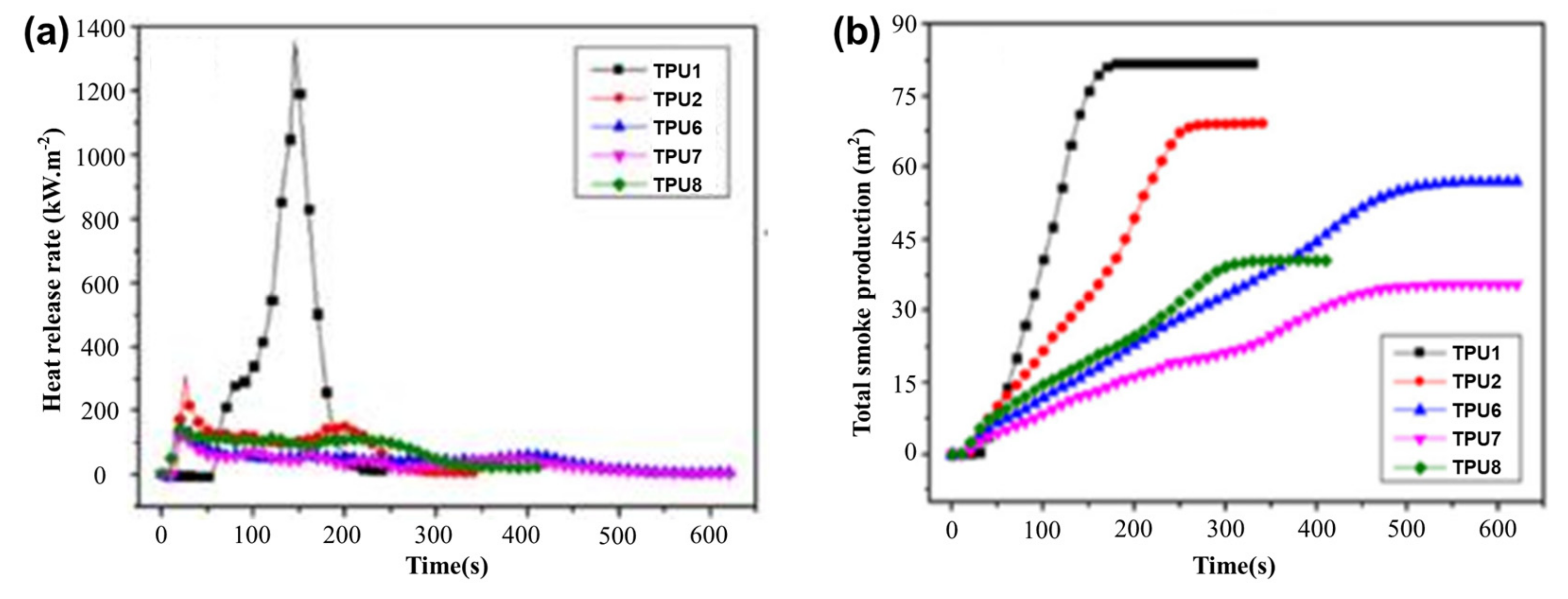



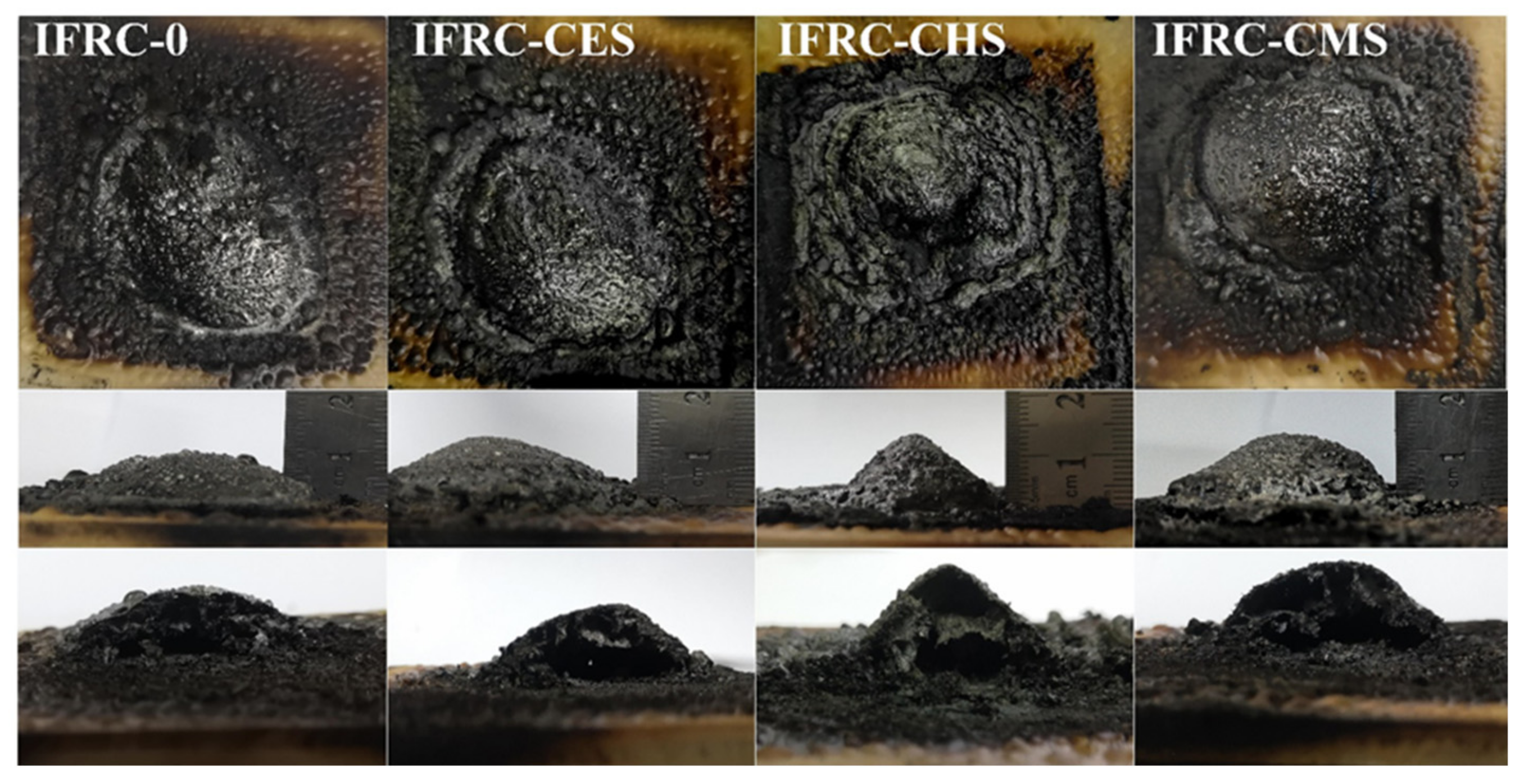
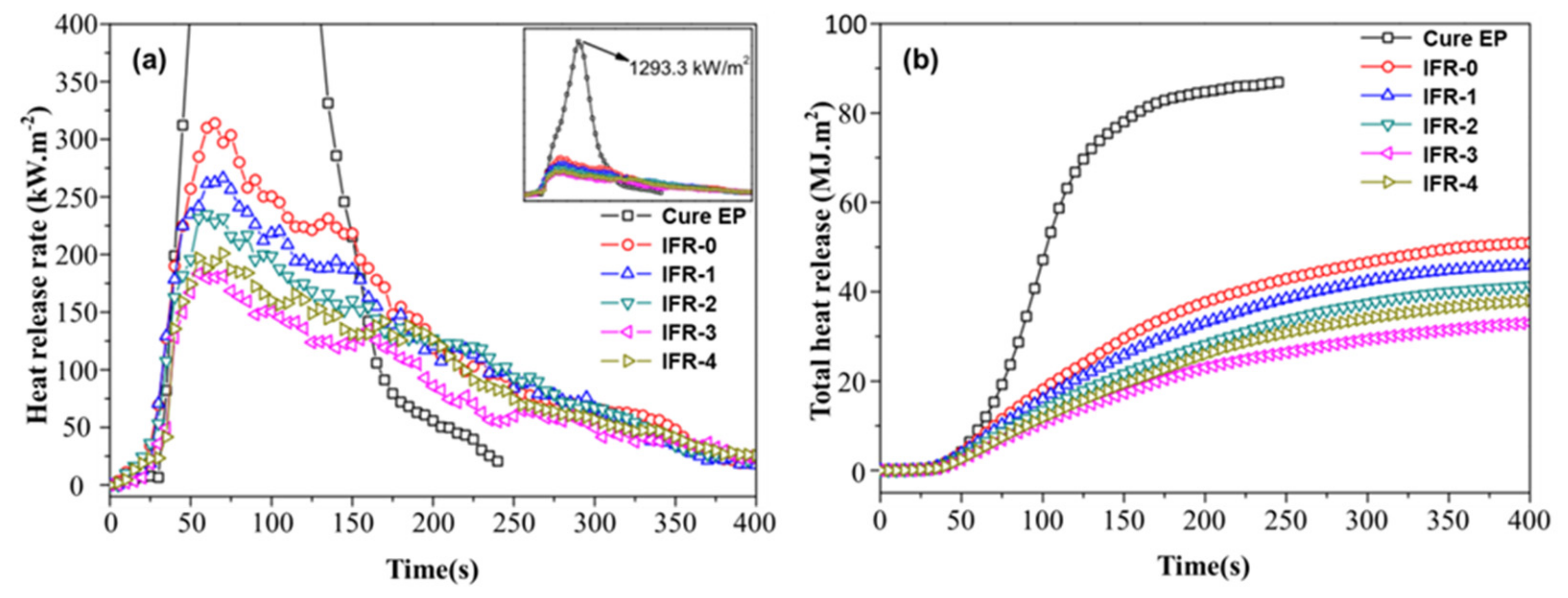

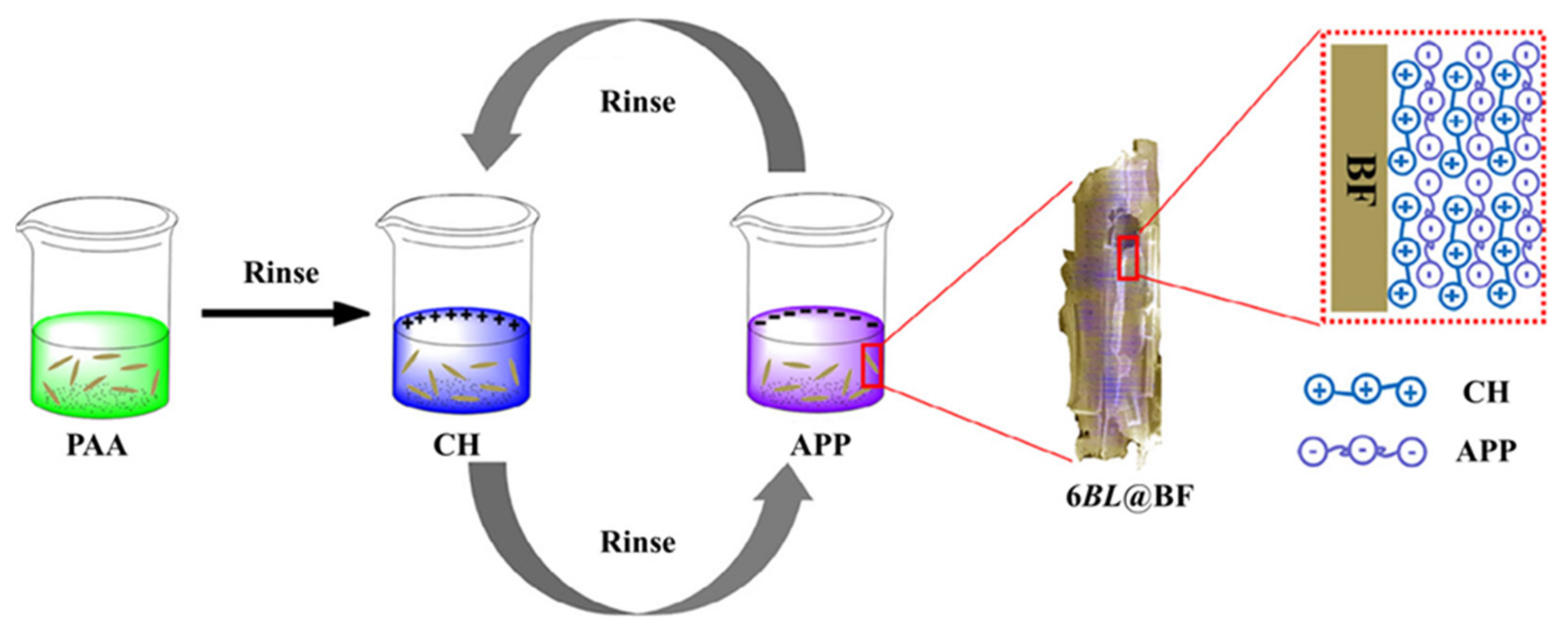

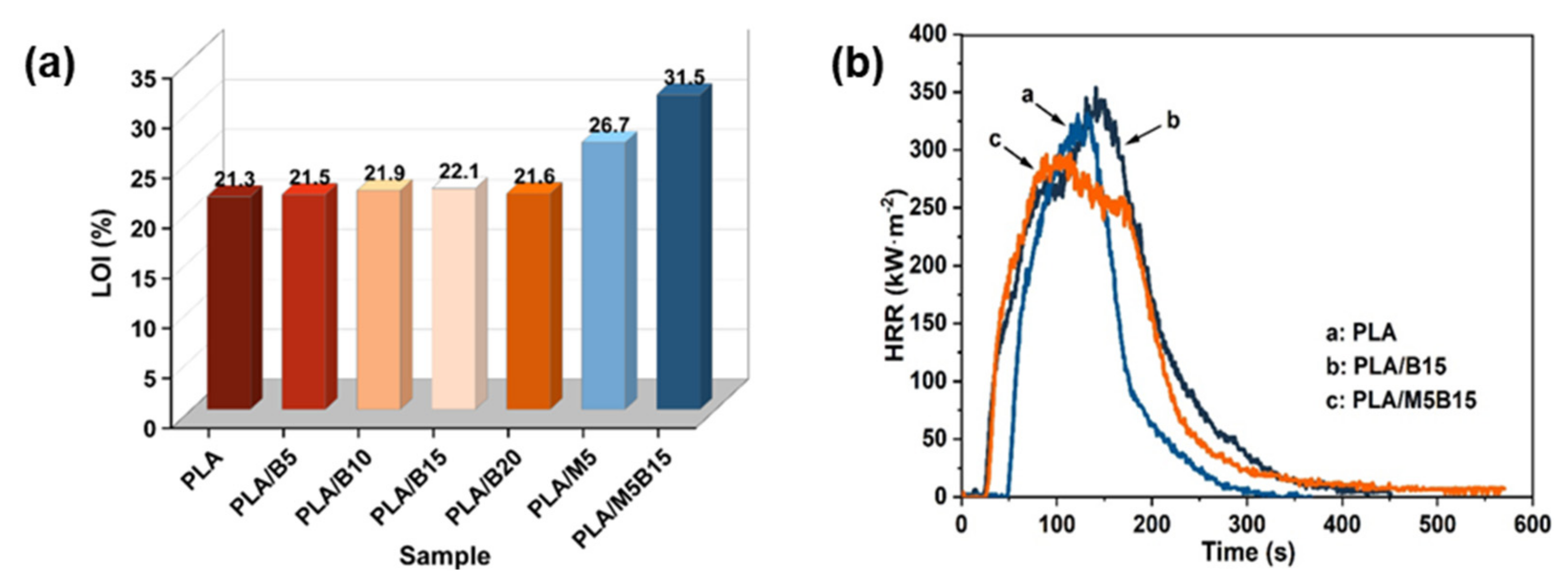

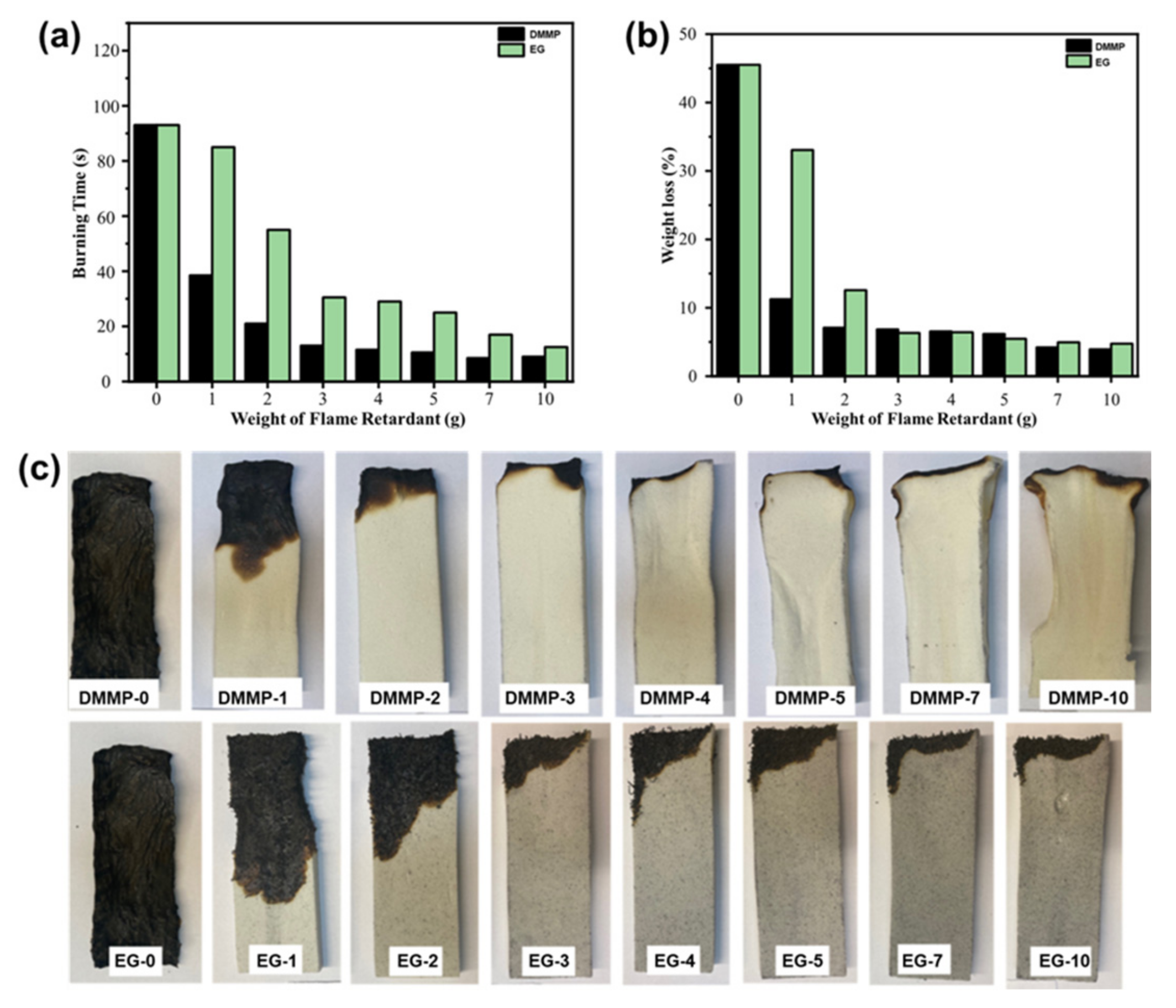


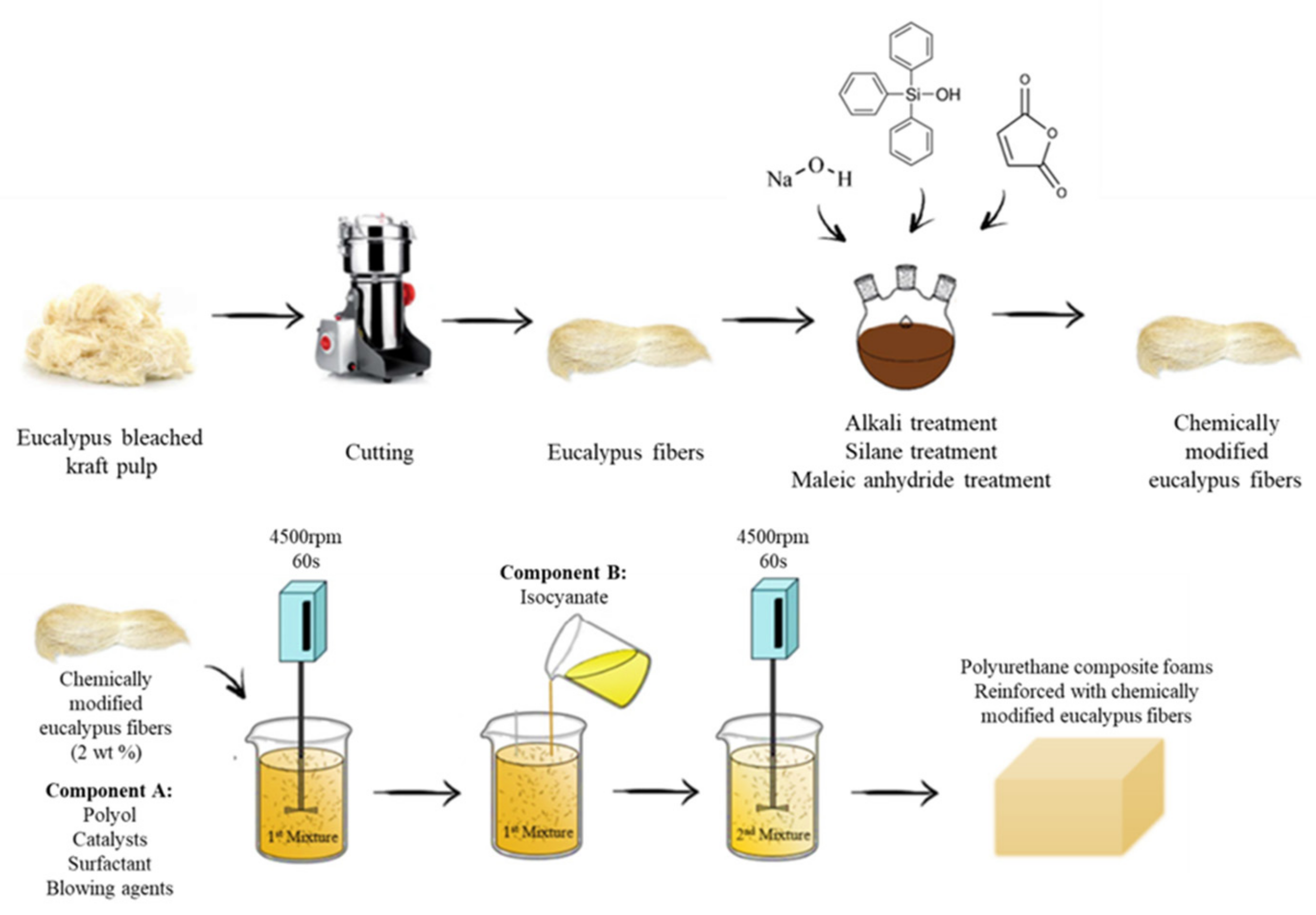
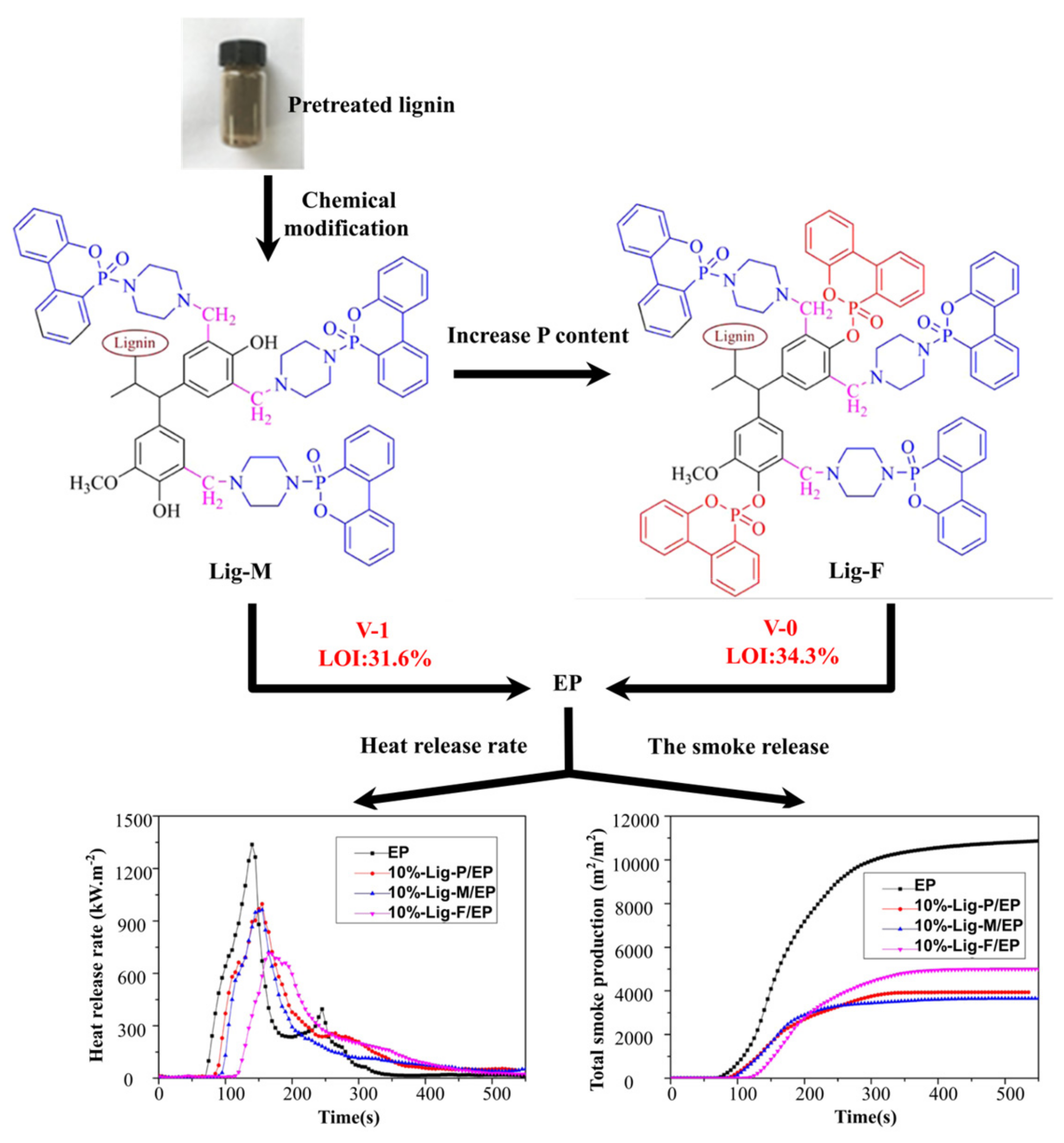
| Polymer | Loading Ratio | LOI (%) | UL-94 | pHRR Decrease (%) | THR Decrease (%) | References |
|---|---|---|---|---|---|---|
| RPUF | 1:1 | / | / | 19.5 ± 0.8 | 33.0 ± 0.8 | [30] |
| TPU | 3:2 | / | / | 84.8 | 55.5 | [31] |
| EP | 3:20 | / | V-2 | / | / | [32] |
| EP | 3:40 | 26.8 ± 0.3 | HB:14.01 mm/min | / | / | [33] |
| PP | 59:1 | 33.0 | V-0 | 58.0 | 5.2 | [34] |
| PS | / | 24.0 | / | / | / | [35] |
| EVA | / | 28.5 ± 0.1 | V-0 | 89.6 ± 0.6 | 24.0 ± 0.7 | [36] |
| Polymer | Loading Ratio | LOI (%) | UL-94 | THR Decrease (%) | References |
|---|---|---|---|---|---|
| RPUF | 1:1 | 22.0 ± 0.5 | / | 44.4 ± 0.4 | [42] |
| RPUF | 1:1 | 23.2 | V-0 | 29.7 | [43] |
| RPUF | 1:1 | 24.0 | V-0 | 47.0 | [44] |
| Polymer | Loading Ratio | LOI (%) | UL-94 | pHRR Decrease (%) | THR Decrease (%) | References |
|---|---|---|---|---|---|---|
| EP | / | 29.0 | V-0 | / | / | [65] |
| EP | / | 29.0 | V-0 | / | / | [66] |
| EP | 3:7 | 24.1 ± 0.2 | V-1 | 64.6 | 13.2 | [67] |
| Polymer | Loading Ratio | LOI (%) | UL-94 | pHRR Decrease (%) | THR Decrease (%) | References |
|---|---|---|---|---|---|---|
| PLA | 1:3 | 31.5 | V-0 | 10.5 | / | [73] |
| PLA | / | 37.5 | V-0 | / | / | [74] |
| Textile | / | 32.0 | HB: 18.29 mm/min | / | / | [75] |
| Polymer | Loading Ratio | LOI (%) | UL-94 | pHRR Decrease (%) | THR Decrease (%) | References |
|---|---|---|---|---|---|---|
| TPU | 4:1 | 30.0 | V-0 | 92.2 | 75.0 | [77] |
| TPU | / | 23.0 | / | 67.5 | 13.0 | [78] |
| TPU | / | / | / | 90.4 | 48.7 | [56] |
| Polymer | Loading Ratio | LOI (%) | UL-94 | pHRR Decrease (%) | THR Decrease (%) | References |
|---|---|---|---|---|---|---|
| EP | 2:1 | 36.2 ± 0.2 | V-0 | / | / | [90] |
| EP | / | / | / | 20.9 | 31.2 | [91] |
| EP | / | 39.0 | V-0 | / | / | [92] |
| PVA | / | 32.8 | V-0 | / | / | [92] |
| PS | / | 28.4 | V-0 | / | / | [92] |
| Polymer | Loading Ratio | LOI (%) | UL-94 | pHRR Decrease (%) | THR Decrease (%) | References |
|---|---|---|---|---|---|---|
| RPUF | / | 22.1 | / | 55.1 | 8.1 | [117] |
| PLA | 2:1 | 38.5 | V-0 | / | / | [118] |
| PLA | / | / | V-0 | 31.4 ± 0.7 | 7.7 ± 1.0 | [119] |
| PLA | / | 27.5 | V-0 | 13.6 ± 0.6 | 19.3 ± 1.0 | [120] |
Disclaimer/Publisher’s Note: The statements, opinions and data contained in all publications are solely those of the individual author(s) and contributor(s) and not of MDPI and/or the editor(s). MDPI and/or the editor(s) disclaim responsibility for any injury to people or property resulting from any ideas, methods, instructions or products referred to in the content. |
© 2024 by the authors. Licensee MDPI, Basel, Switzerland. This article is an open access article distributed under the terms and conditions of the Creative Commons Attribution (CC BY) license (https://creativecommons.org/licenses/by/4.0/).
Share and Cite
Ma, D.-X.; Yin, G.-Z.; Ye, W.; Jiang, Y.; Wang, N.; Wang, D.-Y. Exploiting Waste towards More Sustainable Flame-Retardant Solutions for Polymers: A Review. Materials 2024, 17, 2266. https://doi.org/10.3390/ma17102266
Ma D-X, Yin G-Z, Ye W, Jiang Y, Wang N, Wang D-Y. Exploiting Waste towards More Sustainable Flame-Retardant Solutions for Polymers: A Review. Materials. 2024; 17(10):2266. https://doi.org/10.3390/ma17102266
Chicago/Turabian StyleMa, De-Xin, Guang-Zhong Yin, Wen Ye, Yan Jiang, Na Wang, and De-Yi Wang. 2024. "Exploiting Waste towards More Sustainable Flame-Retardant Solutions for Polymers: A Review" Materials 17, no. 10: 2266. https://doi.org/10.3390/ma17102266
APA StyleMa, D.-X., Yin, G.-Z., Ye, W., Jiang, Y., Wang, N., & Wang, D.-Y. (2024). Exploiting Waste towards More Sustainable Flame-Retardant Solutions for Polymers: A Review. Materials, 17(10), 2266. https://doi.org/10.3390/ma17102266








